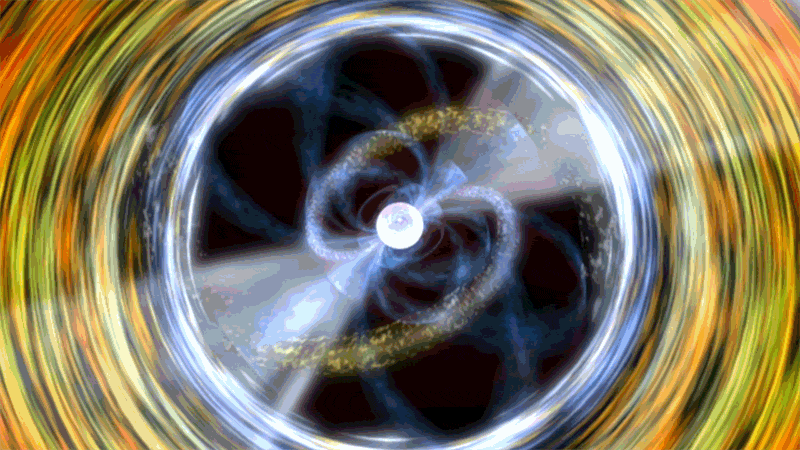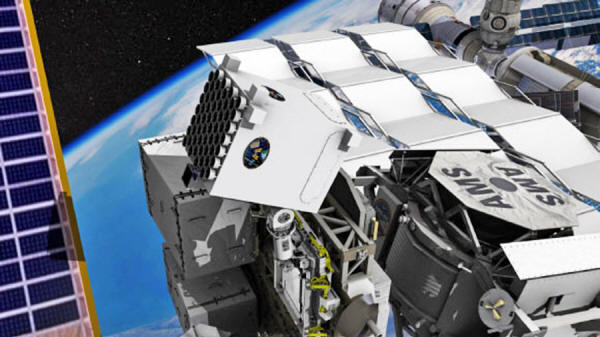|
from
Nature Website while emitting powerful beams of radiation.
Credit:
Dana Berry/NASA how spacecraft could use stellar signals to navigate in deep space without human instruction.
Spacecraft could triangulate their location, in a sort of celestial Global Positioning System (GPS), using clockwork-like signals from distant dead stars.
Last November, the Neutron Star Interior Composition Explorer (NICER) spent a day and a half looking at a handful of pulsars - rapidly spinning stellar remnants that give off beams of powerful radiation as they rotate.
This illustration shows NASA’s NICER mission at work aboard the International Space Station. Image credit: NASA’s Goddard Space Flight Center.
By measuring tiny changes in the arrival time of the pulses, NICER could pinpoint its location to within 5 kilometers.
It is the first demonstration in space of the long-sought technology known as pulsar navigation.
One day, the method could help spacecraft steer themselves without regular instructions from Earth.
Keith Gendreau reported the findings (NICER Mission Overview, Status, and GO opportunities) on 11 January at a meeting of the American Astronomical Society in National Harbor, Maryland.
The NICER work is a useful test of pulsar navigation under real flight conditions, says John Pye, manager of the Space Research Centre at the University of Leicester, UK, who has worked on the idea.
Stellar beacons
Pulsars are the spinning, ultra-dense leftovers of exploded stars. Some emit radiation blasts as often as every few thousandths of a second.
For decades, aerospace engineers have dreamed of using these consistently repeating signals for navigation, just as they use the regular ticking of atomic clocks on satellites for GPS.
In 1999-2000, the US Naval Research Laboratory flew a satellite experiment that showed that, in theory, spacecraft could orient themselves using pulsars.
The European Space Agency has explored the concept in recent years, with researchers calculating that a spacecraft could use pulsars to locate itself with a margin of error of 2 kilometers, even when flying 30 times farther from Earth than the Earth is from the Sun. 1
In November 2016, China launched an experimental pulsar-navigation satellite, called XPNAV-1.
It studied the Crab pulsar, 2,000 parsecs (6,500 light-years) away in the constellation Taurus, as an early test of whether it could lock onto X-ray signals. 2
NICER was installed on the space station in June 2017. Its main job is to measure the size of pulsars to better understand the ultra-dense matter that makes them up.
The pulsar-navigation experiment, known as the Station Explorer for X-ray Timing and Navigation Technology (SEXTANT), is a bonus.
SEXTANT timed X-ray flashes coming from five pulsars, one of which is the closest and brightest known millisecond pulsar. The mission watched each of the beacons for about 5-15 minutes before swiveling autonomously to look at the next.
By measuring tiny changes in the signals' arrival time as the experiment orbited Earth, NICER could independently calculate its own position in space.
Freedom to roam
Without pulsar navigation, spacecraft must communicate with Earth regularly to confirm their position.
But such communication - through systems such as NASA's Deep Space Network, a group of giant satellite dishes - is time-consuming, expensive, and more difficult the farther from Earth a probe travels.
Pulsar navigation might work well for spacecraft in the outer Solar System because it could free probes to do many navigation-related tasks without waiting for instructions, Gendreau.
The technique could also provide an independent check on how well a spacecraft's conventional navigation systems are doing, says Zaven Arzoumanian, an astrophysicist at Goddard who is on the NICER team.
NASA helped fund the test to see whether pulsars could be used as a back-up navigation method when its planned Orion crew capsule takes astronauts beyond low Earth orbit, some time in the 2020s.
NICER used 52 small X-ray telescopes for its study, but a single such telescope could probably do the job, Gendreau says.
The instrument might weigh as little as 5 kilograms, making it relatively inexpensive to add to space missions, where more mass means more money needed to launch.
The team plans to repeat the experiment in the coming months, hoping to reduce the margin of error to one kilometer or less.
Gendreau notes that the famous 'golden record' aboard NASA's Voyager spacecraft carries a map that pinpoints the location of the Solar System relative to 14 pulsars.
If an alien civilization ever found the record, it could use it to locate Earth.
References
|



